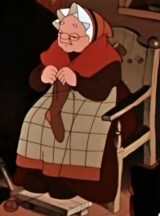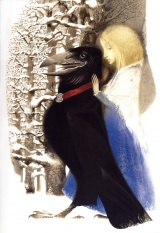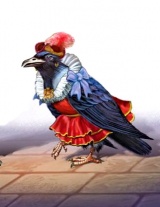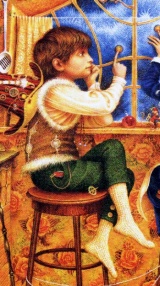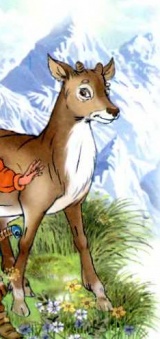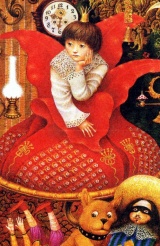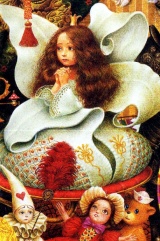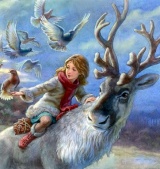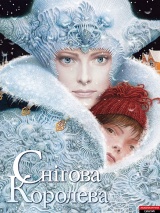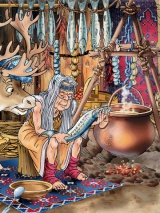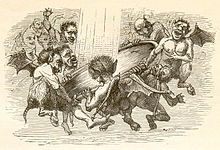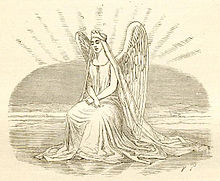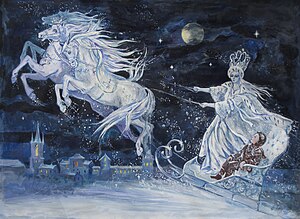Снежная королева: персонажи сказки Андерсена
Бабушка
Grandmother
0
1
0
На датском языке — Bedstemoderen.
Бабушка, рассказывавшая Каю и Герде сказки про Снежную Королеву.
Ворон
Crow
0
2
0
На датском языке — Kragen.
Лесной ворон, подруга которого служила при королевском дворе.
Ворона
Tame Crow
0
1
0
На датском языке — den tamme Krage.
Ворона, состоявшая на службе при королевском дворе.
Герда
Gerda
2
9
4
Главная героиня сказки, подруга Кая. Когда его увозит Снежная Королева, Герда отправляется в путь, чтобы спасти его.
Кай
Kay
0
11
2
Друг Герды. Однажды Кай посылает вызов самой Снежной королеве. В результате в глаз и сердце мальчика попадают осколки «дьявольского зеркала» троллей и Кай меняется. Он становится злым, проказничает, придирается к словам, обижает соседей, Герду и даже бабушку. Одна из проказ Кая окончилась тем, что он привязал свои санки к саням Снежной королевы. Она поцеловала мальчика ледяным поцелуем и увезла в свой дворец, заставив забыть обо всем, что связывало мальчика с миром людей.
Лапландка
Lappish Woman
0
0
0
На датском языке — Lappekonen.
Гостеприимная женщина, которая помогла Герде, отправив вместе с ней послание на рыбе к финке.
Маленькая разбойница
Little Robber Girl
5
3
1
На датском языке — den lille Røverpige.
Дочь атаманши, которая спасла Герду, а потом отпустила ее и даже дала оленя.
Олениха
0
0
0
Молодую олениха, чье вымя было полно молока, ее привел олень, который был другом Герды. Олениха напоила своим молоком Кая и Герду и поцеловала их на прощанье прямо в губы.
Принц
Prince
0
0
0
На датском языке — Prinsen.
Принц, о котором Герда думала, что это может быть Кай.
Принцесса
Princess
0
1
0
На датском языке — Prinsessen.
Принцесса, в чье королевство в поисках Кая пришла Герда.
Северный олень
Bae
0
1
0
Был в неволе у маленькой разбойницы, отпущен на свободу с наказом помогать Герде, довез ее почти до самого замка Снежной королевы. Когда Герда с Каем вышли оттуда, олень привел для них олениху, чтоб она напоила их молоком.
Снежная королева
Snow Queen
6
15
6
Владычица над зимой и смертью, Ледяная Дева, Фея Льдов, Снежная Ведьма — классический персонаж скандинавского фольклора. Царство Снежной королевы — холодное безжизненное пространство, вечные льды и снега. Кая, попавшего в царство Снежной королевы, родные считают погибшим. Снежная королева восседает на троне, стоящем на озере, называемом «зеркалом разума». Она воплощает холодный абсолютный разум и холодную абсолютную красоту, лишенные любых проявлений чувства.
Старая Женщина Умевшая Колдовать (Цветочница)
Old Lady who Knew Magic
0
0
0
На датском языке — den gamle Kone der kunne.
Первый человек, который встретился Герде в ее поисках Кая; колдунья, заколдовала Герду, чтобы она забыла прошлое и осталась у нее; обладательница роскошного сада цветов.
Старуха-разбойница (Атаманша)
Old Robber Woman
0
1
0
На датском языке — den gamle røverkælling.
Главарь разбойников, напавших на карету Герды; мать маленькой разбойницы.
Финка
Finnish Woman
0
0
0
На датском языке — Finnekonen.
Ведунья, которой лапландка передает вместе с Гердой письмо на сушеной рыбе. Олень просит для Герды «питья, которое бы дало ей силу двенадцати богатырей». В ответ финка говорит, что Герде такое питьё и не потребуется: «сила — в её милом, невинном детском сердечке».
«Снежная королева» главные герои

Книги великого датского писателя Андерсена пользуются всемирной популярностью. Огромное место в его творчестве уделено произведениям для детей. Одним из них является сказка Андерсена «Снежная королева». Если верить рассказу одного из биографов, прототипом главной героини «Снежной королевы» стала певица Йенни Линд, к которой писатель испытывал безответную любовь.
Опыт работы учителем русского языка и литературы — 36 лет.
Характеристика героев «Снежная королева
Главные герои
Снежная королева
Правительница Лапландии, равнодушная холодная женщина.
Снежная королева живёт в Лапландии, в краю вечного холода и мерзлоты. Её дворец сделан изо льда, и сама она холодная и бездушная женщина. От её взгляда на окнах появляются узоры, она дышит морозом. Снежная королева является образом вечной зимы и смерти. Это очень умная и красивая женщина, но её красота не несёт добра, королева является воплощением зла и вечного безмолвия. Она не способна испытывать чувств, всегда спокойна и равнодушна.
Кай
Главный герой, названый брат Герды.
Добрый и отзывчивый мальчик, смелый и сильный. Он с уважением относится к старенькой бабушке, нежно любит Герду. Но однажды к нему в глаз и в сердце, попали осколки волшебного зеркала, которое принадлежало злому троллю. С тех пор сердце мальчика стало ледяным и холодным, а глаза стали видеть мир уродливым и кривым.
Герда
Главная героиня, храбрая девочка.
В «Снежной королеве» герои могут не только подчиняться сверхъестественным силам, но и с честью выдерживать все испытания, не поддаваясь чарам и колдовству. Такой бесстрашной девочкой оказалась Герда. Отважно она пустилась на поиски пропавшего Кая. Чтобы найти и спасти его, Герда целеустремлённо движется к цели и побеждает злые чары Снежной королевы.
Второстепенные персонажи
Волшебница
Женщина, встретившаяся девочке на пути.
С помощью волшебных чар пытается оставить Герду в своём волшебном саду, где всегда царит лето. Герда освобождается от её чар с помощью розы.
Принц и принцесса
Молодые люди, узнав историю Герды, помогают ей. Они снабдили ее красивой и богатой одеждой, дали слуг и лошадей, запряжённых в золотую карету.
Маленькая разбойница
Дочка старой атаманши.
Смелая, отважная и дерзкая девчонка. Держит в неволе птиц и животных. Издевается над ними, ей нравится наблюдать, как беззащитные создания испытывают страх. В ее стойле находится северный олень, который знает, где живёт Снежная королева. Маленькая разбойница помогает Герде продолжить поиски Кая.
В этом списке дана характеристика некоторых героев для читательского дневника.
Посмотрите, что еще у нас есть:
Тест по произведению
Доска почёта

Чтобы попасть сюда — пройдите тест.
-
Артём Ларионов
10/10
-
Svet Ppp
9/10
-
Владислав Николаев
10/10
-
Инна Плотицина
9/10
-
Севиля Сеттарова
10/10
-
Илья Прохоренко
10/10
-
Nurai Baubek
10/10
-
Юлия Раентова
10/10
-
Елена Волдаева
9/10
-
Наталия Пимкина
10/10
«Снежная королева»: главные герои сказки
Сказка «Снежная Королева» увидела свет в 1844 году. Интересно, что у этой персонажей этого произведения были реальные прототипы. Так, прообразом Снежной королевы с ледяным сердцем стала оперная певица Йенни Линд, в которую сказочник был безумно влюблен. А Герда воплотилась из маленькой подружки детства Лисбет, с которой Ханс Христиан дружил в раннем детстве.
Главные герои сказки Андерсена «Снежная королева»:
Злой троль – воплощение всего злого. Он создал зеркало, которое добро уменьшало, а зло увеличивало до невероятных размеров.

Кай – мальчик, близкий друг Герды, жил напротив Герды тоже с родителями. Это был добрый мальчик, который любил своих родителей, розы, Герду, книжки с картинками до тех пор, пока ему в глаз не попал осколок дьявольского зеркала, созданного Троллем. После этого случая Кай сильно изменился. Он стал передразнивать знакомых и соседей, выставляя напоказ все их недостатки, передразнивал свою бабушку, в поступках людей, в предметах его окружавших, видел только плохое. Все ему не нравилось. Когда он катался с детьми на санках, его похитила Снежная королева.

Старушка, умевшая колдовать – добрая старушка, колдовала редко, ради собственного удовольствия. Она была очень одинокой и хотела оставить Герду у себя.
Принц и принцесса – молодые супруги, не лишенные справедливости, великодушия. Они щедро одарили Герду и пожелали счастливого пути.
Маленькая разбойница – своенравная девчонка, избалованная, упрямая. В ее сердце странным образом уживались жестокость с великодушием.
Старуха лапландка – жительница Лапландии, встретившаяся Герде и оленю на пути. Она была бедной, жила в ветхой лачуге.
Финка – маленькая толстая женщина. Любила тепло, в доме топила жарко. Была умной. К ней направила Герду лапландка.
Герда нашла Кая. Маленькой храброй девочке помогали люди, звери и птицы. Своими поцелуями Герда растопила лед в сердце Кая, он расплакался, и осколок, сидевший в его глазу, вытек вместе со слезами. Кай стал прежним. Они вернулись домой, и заметили, что за время своего отсутствия стали старше.
| «The Snow Queen» | |
|---|---|
| by Hans Christian Andersen | |
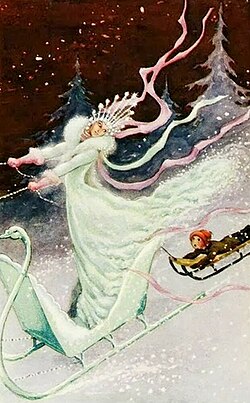
«The Snow Queen» illustration by Rudolf Koivu |
|
| Country | Denmark |
| Language | Danish |
| Genre(s) | Fairy tale |
| Published in | New Fairy Tales. First Volume. Second Collection (Nye Eventyr. Første Bind. Anden Samling)[1] |
| Publication type | Fairy tale collection |
| Publication date | 21 December 1844[1] |
| Full text | |
| External video |
|---|
| Snezhnaya Koroleva [The Snow Queen] [USSR] [1957] on You Channel — English Subtittles |
«The Snow Queen» (Danish: Snedronningen) is an original fairy tale by Danish author Hans Christian Andersen. It was first published 21 December 1844 in New Fairy Tales. First Volume. Second Collection (Nye Eventyr. Første Bind. Anden Samling).[1] The story centers on the struggle between good and evil as experienced by Gerda and her friend, Kai.
The story is one of Andersen’s longest and most highly acclaimed stories. It is regularly included in selected tales and collections of his work and is frequently reprinted in illustrated storybook editions for children.
Story[edit]
The devil, in the form of an evil troll,[2] has made a magic mirror that distorts the appearance of everything that it reflects. The magic mirror fails to reflect the good and beautiful aspects of people and things, and magnifies their bad and ugly aspects. The devil, who is headmaster at a troll school, takes the mirror and his pupils throughout the world, delighting in using it to distort everyone and everything. They attempt to carry the mirror into heaven in order to make fools of the angels and God, but the higher they lift it, the more the mirror shakes as they laugh, and it slips from their grasp and falls back to earth, shattering into billions of pieces, some no larger than a grain of sand. The splinters are blown by the wind all over the Earth and get into people’s hearts and eyes, freezing their hearts like blocks of ice and making their eyes like the troll-mirror itself, seeing only the bad and ugly in people and things.
Vilhelm Pedersen illustration
Years later, a little boy Kai (often spelled «Kay» or «Kaj» in translations) and a little girl Gerda live next door to each other in the garrets of buildings with adjoining roofs in a large city. They could get from one’s home to the other’s just by stepping over the gutters of each building. The two families grow vegetables and roses in window boxes placed on the gutters. Gerda and Kai have a window box garden to play in, and they become devoted to each other as playmates, and as close as if they were siblings.
Kai’s grandmother tells the children about the Snow Queen, who is ruler over the «snow bees» — snowflakes that look like bees. As bees have a queen, so do the snow bees, and she is seen where the snowflakes cluster the most. Looking out of his frosted window one winter, Kai sees the Snow Queen, who beckons him to come with her. Kai draws back in fear from the window.
By the following spring, Gerda has learned a song that she sings to Kai: Roses flower in the vale; there we hear Child Jesus’ tale! Because roses adorn the window box garden, the sight of roses always reminds Gerda of her love for Kai.
On a pleasant summer day, splinters of the troll-mirror get into Kai’s heart and eyes. Kai becomes cruel and aggressive. He destroys their window-box garden, he makes fun of his grandmother, and he no longer cares about Gerda, since everyone now appears bad and ugly to him. The only beautiful and perfect things to him now are the tiny snowflakes that he sees through a magnifying glass.
The following winter, Kai goes out with his sledge to play in the snowy market square and hitches it to a curious white sleigh carriage, driven by the Snow Queen, who appears as a woman in a white fur-coat. Outside the city she reveals herself to Kai and kisses him twice: once to numb him from the cold, and a second time to make him forget about Gerda and his family; a third kiss would kill him. She takes Kai in her sleigh to her palace. The people of the city conclude that Kai died in the nearby river. Gerda, heartbroken, goes out the next summer, to look for him and questions everyone and everything about Kai’s whereabouts. She offers her new red shoes to the river in exchange for Kai; by not taking the gift at first, the river lets her know that Kai did not drown. So Gerda climbs into a boat and the river carries her away, to start her on the right path.
Gerda next visits an old sorceress with a beautiful garden of eternal summer. The sorceress wants Gerda to stay with her forever, so she causes Gerda to forget Kai, and causes all the roses in her garden to sink beneath the earth, since she knows that the sight of them will remind Gerda of her friend. However, a while later, whilst playing in the garden, Gerda sees a rose on the sorceress’s hat, then remembers Kai and begins to cry. Gerda’s warm tears raise one bush above the ground, and it tells her that it could see all the dead while it was under the earth, and Kai is not among them. So she interrogates the other flowers in the garden, but they only know a single story each, which they sing to her. Realizing that they cannot help her find Kai, Gerda flees the garden of eternal summer and realizes that it’s already autumn. She has wasted a lot of time, and has no warm clothes to wear.
Gerda flees and meets a crow, who tells her that Kai is in the princess’s palace. Gerda goes to the palace and meets the princess and the prince, who is not Kai but looks like him. Gerda tells them her story, and they provide her with warm clothes and a beautiful coach. While traveling in the coach Gerda is captured by robbers and brought to their castle, where she befriends a little robber girl, whose pet doves tell her that they saw Kai when he was carried away by the Snow Queen in the direction of Lapland. The captive reindeer Bae tells her that he knows how to get to Lapland since it is his home.
Vilhelm Pedersen illustration
The robber girl frees Gerda and the reindeer to travel north to the Snow Queen’s palace. They make two stops: first at the Lapp woman’s home and then at the Finn woman’s home. The Finn woman tells the reindeer that the secret of Gerda’s unique power to save Kai is in her sweet and innocent child’s heart:
I can give her no greater power than she has already,» said the woman; «don’t you see how strong that is? How men and animals are obliged to serve her, and how well she has got through the world, barefooted as she is. She cannot receive any power from me greater than she now has, which consists in her own purity and innocence of heart. If she cannot herself obtain access to the Snow Queen, and remove the glass fragments from little Kai, we can do nothing to help her…[3]
Vilhelm Pedersen illustration
When Gerda reaches the Snow Queen’s palace, she is halted by the snowflakes guarding it. She prays the Lord’s Prayer, which causes her breath to take the shape of angels, who resist the snowflakes and allow Gerda to enter the palace. Gerda finds Kai alone and almost immobile on a frozen lake, which the Snow Queen calls the «Mirror of Reason», on which her throne sits. Kai is engaged in the task that the Snow Queen gave him: he must use pieces of ice like a Chinese puzzle to form characters and words. If he is able to form the word the Snow Queen told him to spell she will release him from her power and give him a pair of skates.
Gerda runs up to Kai and kisses him, and he is saved by the power of her love: Gerda weeps warm tears on him, melting his heart and burning away the troll-mirror splinter in it. As a result, Kai bursts into tears, which dislodge the splinter from his eye, and becomes cheerful and healthy again. He remembers Gerda, and the two dance around so joyously that the splinters of ice Kai had been playing with are caught up into the dance. When they tire of dancing the splinters fall down to spell «eternity,» the very word Kai was trying to spell. Kai and Gerda leave the Snow Queen’s domain with the help of the reindeer, the Finn woman, and the Lapp woman. They meet the robber girl, and from there they walk back to their home. Kai and Gerda find that everything at home is the same and that it is they who have changed; they are now grown up, and are also delighted to see that it is summertime.
At the end, the grandmother reads a passage from the Bible:
«Assuredly, I say to you, unless you are converted and become as little children, you will by no means enter the Kingdom of Heaven» (Matthew 18:3).
Characters[edit]
Elena Ringo illustration.
- Gerda (), the protagonist and the main heroine of this tale, who succeeds in finding her friend Kai and saving him from the Snow Queen.
- Kai () in Danish and Norwegian (often spelled Kay or Kaj in other European languages including English), a little boy who lives in a large city, in the garret of a building across the street from the home of Gerda, his playmate, whom he loves dearly. He falls victim to the splinters of the troll-mirror and the blandishments of the Snow Queen.
- The Snow Queen (Snedronningen), queen of the snowflakes or «snow bees», who travels throughout the world with the snow. Her palace and gardens are in the lands of permafrost, specifically Spitsbergen. She takes Kai back to this palace after he has fallen victim to the splinters of the troll-mirror. She promises to free Kai if he can spell «eternity» with the pieces of ice in her palace.
- The Troll (Trolden) or the Devil (Djævlen), who makes an evil mirror that distorts reality and later shatters to infect people with its splinters that distort sight and freeze hearts. Some English translations of «The Snow Queen» translate this character as the «sprite» or the «hobgoblin».
- The Grandmother (Bedstemoderen), Kai’s grandmother, who tells him and Gerda the legend of the Snow Queen. Some of Grandmother’s actions are essential points of the story.
- The Old Lady who Knew Magic (den gamle Kone der kunne Trolddom), who maintains a cottage on the river, with a garden that is permanently in summer. She seeks to keep Gerda with her, but Gerda’s thought of roses (the flower most favoured by herself and Kai) awakens her from the old woman’s enchantment.
- The Crow (Kragen), who thinks that the new prince of his land is Kai.
- The Tame Crow (den tamme Krage), who is the mate of the field crow and has the run of the princess’s palace. She lets Gerda into the royal bedchamber in her search for Kai.
- The Princess (Prinsessen), who desires a prince-consort as intelligent as she, and who finds Gerda in her palace. She helps Gerda in her search for Kai by giving her warm, rich clothing, servants, and a golden coach.
- The Prince (Prinsen), formerly a poor young man, who comes to the palace and passes the test set by the princess to become prince.
- The Old Robber Woman (den gamle Røverkælling), the only woman among the robbers who capture Gerda as she travels through their region in a golden coach.
- The Little Robber Girl (den lille Røverpige), daughter of the robber hag. She takes Gerda as a playmate, whereupon her captive doves and reindeer Bae tell Gerda that Kai is with the Snow Queen. The Robber Girl then helps Gerda continue her journey to find Kai.
- Bae (; Bæ), the reindeer who carries Gerda to the Snow Queen’s palace.
- The Lappish Woman (Lappekonen), who provides shelter to Gerda and Kai, and writes a message on a dried cod fish to the Finnish Woman further on the way to the Snow Queen’s gardens.
- The Finnish Woman (Finnekonen), who lives just two miles away from the Snow Queen’s gardens and palace. She knows the secret of Gerda’s power to save Kai.
Jenny Lind[edit]
Andersen met Swedish opera singer Jenny Lind in 1840, and fell in love with her, but she was not interested in him romantically (although the two became friends). According to Carole Rosen, Andersen was inspired to model the icy-hearted Snow Queen on Lind after she rejected him as a suitor.[4]
Media adaptations[edit]
Theatrical films[edit]
- The Snow Queen (1957), a Soviet animated film by film studio Soyuzmultfilm and directed by Lev Atamanov, later dubbed by Universal Studios with the voices of Sandra Dee as Gerda, Tommy Kirk as Kay and introduced by Art Linkletter.[5] In the 1990s, the film was redubbed again, this time featuring the voices of Kathleen Turner, Mickey Rooney, Kirsten Dunst and Laura San Giacomo.[6]
- The Snow Queen (1967), a live-action adaptation from the Soviet Union, directed by Gennadi Kazansky.[7]
- Lumikuningatar (1986), a Finnish live-action adaptation.[8]
- The Snow Queen (1995), a British animated adaptation, directed by Martin Gates and featuring the voices of Helen Mirren (as the title character), David Jason, Hugh Laurie, Rik Mayall, and Imelda Staunton.[9] This adaptation deviates significantly from the original fairy tale. A sequel, titled The Snow Queen’s Revenge, was released the following year.[10]
- Marko Raat’s Lumekuninganna (2010) takes the story to contemporary time and motivates the character inspired by Kai with love towards an older dying woman.
- The Snow Queen, a CG-animated feature film adaptation produced by Russian studio Wizart Animation, Bazelevs Company, and Inlay Film which was released theatrically in Russia on 31 December 2012, internationally on 3 January 2013, and was released in U.S. theaters on 11 October 2013 and U.S. DVD on 26 November 2013.[11][12] Three theatrical sequels were also released: The Snow Queen 2: The Snow King, The Snow Queen 3: Fire and Ice and The Snow Queen: Mirrorlands.
- Frozen, a Disney adaptation.
- Frozen II, a sequel of the Disney adaptation.
Television[edit]
- Hans Christian Andersen Stories (1971) is a Japanese anime series by Mushi Productions and Zuiyo Enterprises and aired on Fuji TV. the 50th and 51st episodes by two parts of the story.
- The Snow Queen (1976), a live-action/animated TV movie released by BBC Enterprises (before restructured as BBC Worldwide), produced by Ian Keill and directed by Andrew Gosling.[13][14]
- A 1985 episode of Faerie Tale Theatre starring Melissa Gilbert as Gerda and Lee Remick as the Snow Queen.[15]
- Tayna snezhnoy korolevy (The Secret of the Snow Queen) (1986), another live-action adaptation from the Soviet Union, featuring Alisa Freindlich as the Snow Queen.[16]
- Anpanman (1988), a long-running series and books created by Takashi Yanase and produced by and animated by TMS Entertainment. The Snow Queen appears in Soreike! Anpanman: Kirakiraboshi no namida and each episodes.
- The Snow Queen (1992), an American animated TV short, narrated by Sigourney Weaver.[17]
- Snedronningen (2000), a Danish live-action television short adaptation, directed by Jacob Jørgensen and Kristof Kuncewicz.[18][19]
- Snow Queen (2002), a television movie by Hallmark, directed by David Wu and starring Bridget Fonda, Jeremy Guilbaut, Chelsea Hobbs, Robert Wisden, and Wanda Cannon.[20]
- The Snow Queen (2005), a BBC television adaptation utilising state of the art effects, merging live-action and computer-generated art.[21] Featuring songs by Paul K. Joyce and starring Juliet Stevenson and the voice of Patrick Stewart, the film was adapted from a 2003 operatic concert held at the Barbican Arts Centre.[22]
- The Fairytaler (alternately titled as Tales from H.C. Andersen), a Danish animated television anthology, has a two-part half-hour adaptation directed by Jorgen Lerdam in 2003.
- The Snow Queen (雪の女王) (2005–2006), a Japanese anime TV series, produced by NHK and animated by TMS Entertainment.
- Koscherfilm[23] has been working on its own adaptation[24] of The Snow Queen[25] based on the children’s book Gerda and Kai-The Snow Queen Book.[26] Richard Koscher announced[27] the script still looks for the right studio and it was released on Christmas 2012.
- Elizabeth Mitchell portrayed the Snow Queen, named Ingrid, in the fourth season of the TV series Once Upon a Time.
- In 2017 British children’s television channel Cbeebies, aired an adaptation of the story as their Christmas pantomime The Snow Queen. It was a scaled down version of the original story but contained all the major characters and written as a musical. As of December 2017 it is viewable on BBC iPlayer.
Video games[edit]
- A text adventure, The Snow Queen, was released by Mosaic Publishing for the ZX Spectrum and Commodore 64 home computers in 1985.
- Rise of the Snow Queen, the 3rd instalment of the Dark Parables Hidden Object PC computer game, is based on both The Snow Queen, & the Snow White fairytale.
- Referenced as a play in Megami Ibunroku Persona for the PlayStation. The mask used in the original play is under a curse, and takes the player through a spin-off of the story.
- In Cookie Run: Kingdom Frost Queen Cookie, Sherbet Cookie and Cotton Cookie portray said story, alternating the glass shard for an illness.
Operas[edit]
- An opera The Snow Queen was written in 1913 by Slovenian composer Lucijan Marija Škerjanc, but it was lost and never performed.[citation needed]
- The children’s opera История Кая и Герды (The Story of Kai and Gerda) was written in 1980 by Russian composer Sergei Petrovich Banevich, (libretto by Tatiana Kalinina). It premiered at the Mariinsky Theatre (then Kirov Theatre) on 24 December 1980.
- The children’s opera The Snow Queen was premiered in 1993 in Toronto as part of the Milk Festival. This is a 60-minute version of the story by Canadian composer John Greer and English librettist Jeremy James Taylor. It was commissioned and premiered by the Canadian Children’s Opera Company, and subsequently performed by them in 2001 and 2019. They also toured the work to the Netherlands and Germany in the summer of 2001.
- The opera La Regina delle Nevi was written in 2010 by Italian composer Pierangelo Valtinoni (Libretto by Paolo Madron) and premiered at the Komische Oper Berlin on October 24, 2010.[28] The opera has since been translated into English, German, Spanish and Swedish and has been performed in numerous countries.
- A family opera «Snödrottningen» in one act with prologue and 13 scenes is composed during 2013-2016 by Swedish composer Benjamin Staern (Libretto by Anelia Kadieva Jonsson) to be premiered at the Malmö Opera on December 17, 2016.
- The Snow Queen, a chamber opera for radio or stage based on Andersen’s story, composed by David Ward and libretto by Kevin Ireland.[29]
- Snedronningen (The Snow Queen) is a free adaptation by the composer Hans Abrahamsen which premiered at the Danish Opera House on 13 October 2019[30][31] and received its first performance in English at the National Theater in Munich on 21 December 2019.[32]
Stage plays and musicals[edit]
The story has been adapted into numerous stage plays and musicals, notably including:
- In 1969 Josef Weinberger produced «The Snow Queen», a Musical Play in Two Acts. Based on the story by Hans Andersen, Book and Lyrics by Winifred Palmer, Musical Score adapted by King Palmer from the Music of Edvard Grieg. The author altered Hans Andersens’ hero ‘Kay’ to ‘Karl’.[33]
- A rock musical adaptation entitled «The Snow Queen: A New Musical».[34] was produced by San Jose Repertory Theatre in December 2013,[35] with music by Haddon Kime, book by Rick Lombardo and Kirsten Brandt, and lyrics by Kime, Brandt, and Lombardo. This adaptation received positive reviews,[36] after also being produced at the 2014 New York Musical Theatre Festival.[37]
- An adaptation written by Preston Lane that uses Appalachian culture to tell the story premiered at Triad Stage in 2013.[38]
- Another adaptation of «The Snow Queen» made its world premiere at the Hippodrome State Theatre in Gainesville, FL in November 2015. This adaptation was written and directed by Charlie Mitchell, with original songs by Mitchell and Brian Mercer.
- «The Snow Queen» was adapted as a radio play by Garrison Keillor, released on September 2, 2010
- «The Snow Queen» by Missoula children’s theatre played in several locations including Estevan and Humboldt.
- «The Snow Queen» was adapted as an audiobook by Jennifer Charles, released by Ojet Records on December 23, 2020
Dance productions[edit]
- The first full-length ballet production of The Snow Queen was choreographed and produced by Aerin Holt and California Contemporary Ballet in December 1998 with an original score by Randall Michael Tobin. The ballet ran for 16 consecutive Decembers from 1998 to 2013. In December 2017 The Snow Queen Ballet returns for three performances in celebration of the 20th anniversary of California Contemporary Ballet.[39]
- An Off-Broadway dance theater adaptation of The Snow Queen was choreographed and produced by Angela Jones and Noel MacDuffie in 1999 with an original score by John LaSala. The soundtrack was released as an album on TownHall Records in 2000.[40]
- On 11 October 2007, the English National Ballet premiered a three-act version of The Snow Queen, choreographed by Michael Corder with a score drawn from the music of Sergei Prokofiev’s The Stone Flower, arranged by Julian Philips.[41]
- On 23 November 2012, the Finnish National Ballet premiered a two-act version of The Snow Queen, choreographed by Kenneth Greve, music by Tuomas Kantelinen.[42][43]
- On 22 March 2016, the Grand Theatre, Poznań premiered a two-act version of The Snow Queen, directed by Anna Niedźwiedź, music by Gabriel Kaczmarek.[44]
- On 8 April 2017, the Eugene Ballet (OR) premiered a new full-length ballet, The Snow Queen, choreographed by Toni Pimble with original music by Kenji Bunch.[45] The music was released on the Innova Records label to great acclaim.[46]
- Scottish Ballet staged a full-length Snow Queen ballet in two acts, choreographed by Chistopher Hampson and Ashley Page, to a score arranged from music by Nikolai Rimsky-Korsakov in 2018; filmed by BBC television in 2019, rebroadcast 2020.[47] The scenario borrows elements, such as the Snow Queen’s sister, the wolves and the splintering palace, from the Walt Disney movie Frozen.
Inspired works[edit]
Literature
- The Snow Queen by Evgeny Shvarts (1937): A play by the famous Soviet author loosely based on Andersen’s tale, with the introduction of new characters such as the Councillor of Commerce, dealing with ice and therefore close ally of the Snow Queen.
- The Lion, the Witch, and the Wardrobe (1950): It is possible that the White Witch from C. S. Lewis’s novel may be inspired by the Snow Queen, as she turned Narnia into a snow-covered land, is also depicted as wearing a white fur coat and first appears riding in a sleigh, and kidnapped a boy.[48]
- The Snow Queen by Joan D. Vinge (1980): A science fiction novel loosely based on Andersen’s tale.
- Assumptions by Marilyn Hacker (1985): contains an eight-poem sequence, «The Snow Queen,» about Gerda, the Robber Girl, and the Finland Woman.
- The Snow Queen by Mercedes Lackey (2008): book four of the Five Hundred Kingdoms series, set in a fantasy world where fairy tales happen over and over in a never-ending cycle. The Snow Queen is a harsh persona adopted by a benevolent sorceress (called a Godmother in this world) also known as the Ice Fairy to ensure that the kingdoms under her care get their happy endings. Andersen’s tale is featured as a subplot within the novel, which tells an original story incorporating other myths and legends of the Sámi people and of other Scandinavian countries.
- In the comic book Fables, the Snow Queen and Kai appear as minor characters.
- «The Cryomancer’s Daughter (Murder Ballad No. 3)» by Caitlín R. Kiernan is a retelling of The Snow Queen.
- «The Player» (1992): Directed by Robert Altman, written by Michael Tolkin. Several traits of Greta Scachi’s character, June Gudmundsdotir, seem to be references to The Snow Queen story.
- Winter’s Child by Cameron Dokey (2009) is a young adult novel that closely follows the story of «The Snow Queen».
- «The Snow Queen’s Shadow», by Jim C. Hines (2011), part of his Princess Series. Snow White is transformed into the Snow Queen when a spell goes wrong and her magic mirror shatters.
- Breadcrumbs by Anne Ursu is a children’s book set in modern times that is heavily inspired by the plot of «The Snow Queen.»
- French artist Stéphane Blanquet illustrated a version of the Snow Queen published in France in 2010 by Gallimard Jeunesse (ISBN 9782070641154)[49]
- Ophelia and the Marvelous Boy by Karen Foxleen is a children’s book set in modern times featuring the Snow Queen and other elements from the fairy tale.[50]
- The book The Raven & The Reindeer by T. Kingfisher is a retelling of Andersen’s tale where Gerta (Gerda) finds herself re-examining her attachment to the cold and selfish Kay (Kai) on her journey to rescue him.
- The Grimoire of Kensington Market by Lauren B. Davis (2018) is a novel about the opioid epidemic and the effects of addiction on the family and community, inspired by The Snow Queen.
Media
- The webcomic Demon’s Mirror is a retelling of The Snow Queen.
- A first-season episode of A Different World, «Rudy and the Snow Queen» (1987), involves the character of Whitley Gilbert (Jasmine Guy) retelling the story of the Snow Queen to The Cosby Show’s Rudy Huxtable (Keshia Knight-Pulliam), who has become so admiring of Whitley that she is ignoring Denise (Lisa Bonet), the older sister that Rudy came to visit. In Whitley’s version of the tale, Kai is Gerda’s little sister, and Rudy envisions Whitley as the beautiful queen. The crossover episode also includes a cameo appearance by the creator of both series, Bill Cosby, in character as Dr. Heathcliff Huxtable.[51]
- Sailor Moon S: The Movie (1994) The second movie of the popular anime series Sailor Moon has the Sailor Senshi dealing with a powerful Snow Princess who intends to freeze the entire Earth and make it her possession. The final season of the series Sailor Stars, also heavily borrows from the story for its opening arc; Queen Nehelenia breaks a mirror and the shards of it fall to the earth. One of the fragments get into Mamoru’s eye making him cold and distant. When Nehelenia takes him to a palace in the arctic, Sailor Moon must travel there to rescue him.
- A 2000 episode of Happily Ever After: Fairy Tales for Every Child, featuring Eartha Kitt as the voice of the Snow Queen in an Inuit setting.[52]
- The Ever After High animated movie, Epic Winter (2016) uses elements of the story.
- The Huntsman: Winter’s War (2016), a prequel and sequel to Snow White and the Huntsman, is based on characters from the German fairy tale «Snow White» compiled by the Brothers Grimm as well as «The Snow Queen» by Hans Christian Andersen.
- «The Snow Queen» inspired Seohyun’s concept photo for Girls’ Generation’s third studio album The Boys.
- In December, 2011, Blue Tea Games and Big Fish Games released Rise of the Snow Queen, the 3rd instalment of their Dark Parables media franchise. The storyline features elements from the Brothers Grimm’s «Snow White» and Hans Christian Andersen’s «The Snow Queen».
- The video game Revelations: Persona and its PSP remake made by Atlus, one of the paths the main story can take features the protagonist’s school transform into an ice castle. It is ruled by the Snow Queen’s mask, who takes over the mind of the protagonist’s homeroom teacher. To progress through to story, the player must collect mirror shards to repair a mirror to use against the will of the mask.
- The song Schneekönigin (Snow Queen), by the German folk metal group Subway to Sally, tells of the Snow Queen coming to get the narrator, presumably Kai, to bring him back to her land of ice and silence.[53]
- The 2013 3D computer-animated musical Walt Disney Animation Studios film Frozen was inspired by «The Snow Queen», and closely followed the original Andersen story early in the film’s development. The film has since been adapted to a successful Broadway musical, also produced by Disney.
References[edit]
- ^ a b c «Hans Christian Andersen : The Snow Queen». sdu.dk.
- ^ Andersen, Hans Christian (1983). «The Snow Queen». The Complete Fairy Tales and Stories. trans. Erik Christian Haugaard. United States: Anchor Books. ISBN 9780307777898. Retrieved 3 December 2013.
- ^ cf. Sixth Story: The Lapland Woman and the Finland Woman»
- ^ Rosen, Carole (2004). «Lind, Jenny (1820–1887)». In Matthew, H. C. G.; Harrison, Brian (eds.). Oxford Dictionary of National Biography. Oxford University Press. ISBN 978-0198614111. Retrieved 1 April 2014.
[W]hen [Lind] rejected him as a suitor she became the Snow Queen, whose heart was made of ice.
- ^ Snezhnaya koroleva at IMDb
- ^ «The Snow Queen» at IMDb
- ^ Snezhnaya koroleva at IMDb
- ^ Lumikuningatar at IMDb
- ^ The Snow Queen at IMDb
- ^ The Snow Queen’s Revenge at IMDb
- ^ «Snow Queen». Wizart Animation. Retrieved 23 December 2011.
- ^ «Snow Queen (2012) — IMDb» – via www.imdb.com.
- ^ «The Snow Queen: BBC Version». amazon.co.uk.
- ^ The Snow Queen at the British Film Institute
- ^ «The Snow Queen» at IMDb
- ^ Tayna snezhnoy korolevy at IMDb
- ^ The Snow Queen at IMDb
- ^ Snedronningen at IMDb
- ^ «Snedronningen | Det Danske Filminstitut».
- ^ Snow Queen at IMDb
- ^ The Snow Queen at IMDb
- ^ «Arts — The Times». timesonline.co.uk.
- ^ The Snow Queen — The Movie ( TXU-001-650-698 — WGA 1382055) Archived 2012-04-25 at the Wayback Machine
- ^ The Snow Queen — based on H.C. Andersen. YouTube. 23 September 2011.
- ^ «The Snow Queen — The Movie ( TXU-001-650-698 — WGA 1382055)». thesnowqueenmovie.com. Archived from the original on 25 April 2012.
- ^ «Gerda and Kai — The Snow Queen Book by Richard Koscher». Gerda and Kai — The Snow Queen Book. Archived from the original on 3 October 2011.
- ^ «Richard Koscher ist in vielen Medien zu Hause > Kleine Zeitung».
- ^ «Pierangelo Valtinoni — Die Schneekönigin». Boosey & Hawkes: The Classical Music Specialists. Retrieved 25 December 2016.
- ^ «The Snow Queen». 5 July 1985. p. 66 – via BBC Genome.
- ^ «The Royal Danish Opera». kglteater.dk/en. Retrieved 5 October 2019.
- ^ Clements, Andrew (14 October 2019). «Snedronningen (The Snow Queen) review – Abrahamsen’s opera fails to melt hearts». The Guardian. Retrieved 14 October 2019.
- ^ Staatsoper, Bayerische. «THE SNOW QUEEN». Bayerische Staatsoper. Retrieved 5 October 2019.
- ^ «The Snow Queen». The Guide to Musical Theatre. Retrieved 8 July 2014.
- ^ «The Snow Queen: A New Musical». Steele Spring Stage Rights. 12 January 2015. Retrieved 8 July 2014.
- ^ «San Jose Repertory Theatre». Sjrep.com. 22 December 2013. Archived from the original on 28 June 2014. Retrieved 8 July 2014.
- ^ Gates, Anita (21 July 2014). «A Fairy-Tale That Rocks’ — The Snow Queen,’ Based on a Hans Christian Andersen Story». The New York Times. New York City.
- ^ «The New York Musical Theatre Festival :: The Snow Queen». Nymf.org. 13 December 2013. Retrieved 8 July 2014.
- ^ «Snow Queen». triadstage.org.
- ^ «The Snow Queen Ballet |». snowqueenballet.com.
- ^ «The Snow Queen». TownHall Records. Archived from the original on 24 February 2012. Retrieved 25 April 2012.
- ^ «The Snow Queen, The Coliseum, London». The Independent. Archived from the original on 18 June 2022. Retrieved 29 January 2014.
- ^ «The Snow Queen». opera.fi. Retrieved 29 September 2013.
- ^ [1] helsinkitimes.fi (23 October 2014). Retrieved on 21 July 2016.
- ^ «The Snow Queen». opera.poznan.pl. Archived from the original on 31 May 2016. Retrieved 29 April 2016.
- ^ Alan, Eric (4 April 2017). «The Snow Queen: Eugene Ballet’s World Premiere, with Score from Kenji Bunch and Orchestra Next». www.klcc.org. Retrieved 23 December 2019.
- ^ «The Snow Queen». Orchestra NEXT. 23 June 2017. Retrieved 23 December 2019.
- ^ «The Snow Queen». Scottish Ballet. 12 July 2021.
- ^ «No sex in Narnia? How Hans Christian Andersen’s «Snow Queen» problematizes C. S. Lewis’s The Chronicles of Narnia». thefreelibrary.com.
- ^ «La Reine des Neiges». gallimard-jeunesse.fr.
- ^ Spires, Elizabeth (14 February 2014). «‘Ophelia and the Marvelous Boy,’ by Karen Foxlee». The New York Times.
- ^ Unnamed author. «Rudy and the Snow Queen» (episode description), Kalamazoo Public Library. Retrieved 2021-12-23.
- ^ «The Snow Queen» at IMDb
- ^ xXPayongXx (21 June 2011). «Subway to Sally — Schneekönigin». Archived from the original on 11 December 2021 – via YouTube.
External links[edit]
Wikisource has original text related to this article:
- The Snow Queen at the Hans Christian Andersen website
- SurLaLune’s Annotated The Snow Queen
- Free audiobook from LibriVox
- SnowQueenBallet.com
- The Snow Queen: A New Musical
The Snow Queen public domain audiobook at LibriVox
| «The Snow Queen» | |
|---|---|
| by Hans Christian Andersen | |

«The Snow Queen» illustration by Rudolf Koivu |
|
| Country | Denmark |
| Language | Danish |
| Genre(s) | Fairy tale |
| Published in | New Fairy Tales. First Volume. Second Collection (Nye Eventyr. Første Bind. Anden Samling)[1] |
| Publication type | Fairy tale collection |
| Publication date | 21 December 1844[1] |
| Full text | |
| External video |
|---|
| Snezhnaya Koroleva [The Snow Queen] [USSR] [1957] on You Channel — English Subtittles |
«The Snow Queen» (Danish: Snedronningen) is an original fairy tale by Danish author Hans Christian Andersen. It was first published 21 December 1844 in New Fairy Tales. First Volume. Second Collection (Nye Eventyr. Første Bind. Anden Samling).[1] The story centers on the struggle between good and evil as experienced by Gerda and her friend, Kai.
The story is one of Andersen’s longest and most highly acclaimed stories. It is regularly included in selected tales and collections of his work and is frequently reprinted in illustrated storybook editions for children.
Story[edit]
The devil, in the form of an evil troll,[2] has made a magic mirror that distorts the appearance of everything that it reflects. The magic mirror fails to reflect the good and beautiful aspects of people and things, and magnifies their bad and ugly aspects. The devil, who is headmaster at a troll school, takes the mirror and his pupils throughout the world, delighting in using it to distort everyone and everything. They attempt to carry the mirror into heaven in order to make fools of the angels and God, but the higher they lift it, the more the mirror shakes as they laugh, and it slips from their grasp and falls back to earth, shattering into billions of pieces, some no larger than a grain of sand. The splinters are blown by the wind all over the Earth and get into people’s hearts and eyes, freezing their hearts like blocks of ice and making their eyes like the troll-mirror itself, seeing only the bad and ugly in people and things.
Vilhelm Pedersen illustration
Years later, a little boy Kai (often spelled «Kay» or «Kaj» in translations) and a little girl Gerda live next door to each other in the garrets of buildings with adjoining roofs in a large city. They could get from one’s home to the other’s just by stepping over the gutters of each building. The two families grow vegetables and roses in window boxes placed on the gutters. Gerda and Kai have a window box garden to play in, and they become devoted to each other as playmates, and as close as if they were siblings.
Kai’s grandmother tells the children about the Snow Queen, who is ruler over the «snow bees» — snowflakes that look like bees. As bees have a queen, so do the snow bees, and she is seen where the snowflakes cluster the most. Looking out of his frosted window one winter, Kai sees the Snow Queen, who beckons him to come with her. Kai draws back in fear from the window.
By the following spring, Gerda has learned a song that she sings to Kai: Roses flower in the vale; there we hear Child Jesus’ tale! Because roses adorn the window box garden, the sight of roses always reminds Gerda of her love for Kai.
On a pleasant summer day, splinters of the troll-mirror get into Kai’s heart and eyes. Kai becomes cruel and aggressive. He destroys their window-box garden, he makes fun of his grandmother, and he no longer cares about Gerda, since everyone now appears bad and ugly to him. The only beautiful and perfect things to him now are the tiny snowflakes that he sees through a magnifying glass.
The following winter, Kai goes out with his sledge to play in the snowy market square and hitches it to a curious white sleigh carriage, driven by the Snow Queen, who appears as a woman in a white fur-coat. Outside the city she reveals herself to Kai and kisses him twice: once to numb him from the cold, and a second time to make him forget about Gerda and his family; a third kiss would kill him. She takes Kai in her sleigh to her palace. The people of the city conclude that Kai died in the nearby river. Gerda, heartbroken, goes out the next summer, to look for him and questions everyone and everything about Kai’s whereabouts. She offers her new red shoes to the river in exchange for Kai; by not taking the gift at first, the river lets her know that Kai did not drown. So Gerda climbs into a boat and the river carries her away, to start her on the right path.
Gerda next visits an old sorceress with a beautiful garden of eternal summer. The sorceress wants Gerda to stay with her forever, so she causes Gerda to forget Kai, and causes all the roses in her garden to sink beneath the earth, since she knows that the sight of them will remind Gerda of her friend. However, a while later, whilst playing in the garden, Gerda sees a rose on the sorceress’s hat, then remembers Kai and begins to cry. Gerda’s warm tears raise one bush above the ground, and it tells her that it could see all the dead while it was under the earth, and Kai is not among them. So she interrogates the other flowers in the garden, but they only know a single story each, which they sing to her. Realizing that they cannot help her find Kai, Gerda flees the garden of eternal summer and realizes that it’s already autumn. She has wasted a lot of time, and has no warm clothes to wear.
Gerda flees and meets a crow, who tells her that Kai is in the princess’s palace. Gerda goes to the palace and meets the princess and the prince, who is not Kai but looks like him. Gerda tells them her story, and they provide her with warm clothes and a beautiful coach. While traveling in the coach Gerda is captured by robbers and brought to their castle, where she befriends a little robber girl, whose pet doves tell her that they saw Kai when he was carried away by the Snow Queen in the direction of Lapland. The captive reindeer Bae tells her that he knows how to get to Lapland since it is his home.
Vilhelm Pedersen illustration
The robber girl frees Gerda and the reindeer to travel north to the Snow Queen’s palace. They make two stops: first at the Lapp woman’s home and then at the Finn woman’s home. The Finn woman tells the reindeer that the secret of Gerda’s unique power to save Kai is in her sweet and innocent child’s heart:
I can give her no greater power than she has already,» said the woman; «don’t you see how strong that is? How men and animals are obliged to serve her, and how well she has got through the world, barefooted as she is. She cannot receive any power from me greater than she now has, which consists in her own purity and innocence of heart. If she cannot herself obtain access to the Snow Queen, and remove the glass fragments from little Kai, we can do nothing to help her…[3]
Vilhelm Pedersen illustration
When Gerda reaches the Snow Queen’s palace, she is halted by the snowflakes guarding it. She prays the Lord’s Prayer, which causes her breath to take the shape of angels, who resist the snowflakes and allow Gerda to enter the palace. Gerda finds Kai alone and almost immobile on a frozen lake, which the Snow Queen calls the «Mirror of Reason», on which her throne sits. Kai is engaged in the task that the Snow Queen gave him: he must use pieces of ice like a Chinese puzzle to form characters and words. If he is able to form the word the Snow Queen told him to spell she will release him from her power and give him a pair of skates.
Gerda runs up to Kai and kisses him, and he is saved by the power of her love: Gerda weeps warm tears on him, melting his heart and burning away the troll-mirror splinter in it. As a result, Kai bursts into tears, which dislodge the splinter from his eye, and becomes cheerful and healthy again. He remembers Gerda, and the two dance around so joyously that the splinters of ice Kai had been playing with are caught up into the dance. When they tire of dancing the splinters fall down to spell «eternity,» the very word Kai was trying to spell. Kai and Gerda leave the Snow Queen’s domain with the help of the reindeer, the Finn woman, and the Lapp woman. They meet the robber girl, and from there they walk back to their home. Kai and Gerda find that everything at home is the same and that it is they who have changed; they are now grown up, and are also delighted to see that it is summertime.
At the end, the grandmother reads a passage from the Bible:
«Assuredly, I say to you, unless you are converted and become as little children, you will by no means enter the Kingdom of Heaven» (Matthew 18:3).
Characters[edit]
Elena Ringo illustration.
- Gerda (), the protagonist and the main heroine of this tale, who succeeds in finding her friend Kai and saving him from the Snow Queen.
- Kai () in Danish and Norwegian (often spelled Kay or Kaj in other European languages including English), a little boy who lives in a large city, in the garret of a building across the street from the home of Gerda, his playmate, whom he loves dearly. He falls victim to the splinters of the troll-mirror and the blandishments of the Snow Queen.
- The Snow Queen (Snedronningen), queen of the snowflakes or «snow bees», who travels throughout the world with the snow. Her palace and gardens are in the lands of permafrost, specifically Spitsbergen. She takes Kai back to this palace after he has fallen victim to the splinters of the troll-mirror. She promises to free Kai if he can spell «eternity» with the pieces of ice in her palace.
- The Troll (Trolden) or the Devil (Djævlen), who makes an evil mirror that distorts reality and later shatters to infect people with its splinters that distort sight and freeze hearts. Some English translations of «The Snow Queen» translate this character as the «sprite» or the «hobgoblin».
- The Grandmother (Bedstemoderen), Kai’s grandmother, who tells him and Gerda the legend of the Snow Queen. Some of Grandmother’s actions are essential points of the story.
- The Old Lady who Knew Magic (den gamle Kone der kunne Trolddom), who maintains a cottage on the river, with a garden that is permanently in summer. She seeks to keep Gerda with her, but Gerda’s thought of roses (the flower most favoured by herself and Kai) awakens her from the old woman’s enchantment.
- The Crow (Kragen), who thinks that the new prince of his land is Kai.
- The Tame Crow (den tamme Krage), who is the mate of the field crow and has the run of the princess’s palace. She lets Gerda into the royal bedchamber in her search for Kai.
- The Princess (Prinsessen), who desires a prince-consort as intelligent as she, and who finds Gerda in her palace. She helps Gerda in her search for Kai by giving her warm, rich clothing, servants, and a golden coach.
- The Prince (Prinsen), formerly a poor young man, who comes to the palace and passes the test set by the princess to become prince.
- The Old Robber Woman (den gamle Røverkælling), the only woman among the robbers who capture Gerda as she travels through their region in a golden coach.
- The Little Robber Girl (den lille Røverpige), daughter of the robber hag. She takes Gerda as a playmate, whereupon her captive doves and reindeer Bae tell Gerda that Kai is with the Snow Queen. The Robber Girl then helps Gerda continue her journey to find Kai.
- Bae (; Bæ), the reindeer who carries Gerda to the Snow Queen’s palace.
- The Lappish Woman (Lappekonen), who provides shelter to Gerda and Kai, and writes a message on a dried cod fish to the Finnish Woman further on the way to the Snow Queen’s gardens.
- The Finnish Woman (Finnekonen), who lives just two miles away from the Snow Queen’s gardens and palace. She knows the secret of Gerda’s power to save Kai.
Jenny Lind[edit]
Andersen met Swedish opera singer Jenny Lind in 1840, and fell in love with her, but she was not interested in him romantically (although the two became friends). According to Carole Rosen, Andersen was inspired to model the icy-hearted Snow Queen on Lind after she rejected him as a suitor.[4]
Media adaptations[edit]
Theatrical films[edit]
- The Snow Queen (1957), a Soviet animated film by film studio Soyuzmultfilm and directed by Lev Atamanov, later dubbed by Universal Studios with the voices of Sandra Dee as Gerda, Tommy Kirk as Kay and introduced by Art Linkletter.[5] In the 1990s, the film was redubbed again, this time featuring the voices of Kathleen Turner, Mickey Rooney, Kirsten Dunst and Laura San Giacomo.[6]
- The Snow Queen (1967), a live-action adaptation from the Soviet Union, directed by Gennadi Kazansky.[7]
- Lumikuningatar (1986), a Finnish live-action adaptation.[8]
- The Snow Queen (1995), a British animated adaptation, directed by Martin Gates and featuring the voices of Helen Mirren (as the title character), David Jason, Hugh Laurie, Rik Mayall, and Imelda Staunton.[9] This adaptation deviates significantly from the original fairy tale. A sequel, titled The Snow Queen’s Revenge, was released the following year.[10]
- Marko Raat’s Lumekuninganna (2010) takes the story to contemporary time and motivates the character inspired by Kai with love towards an older dying woman.
- The Snow Queen, a CG-animated feature film adaptation produced by Russian studio Wizart Animation, Bazelevs Company, and Inlay Film which was released theatrically in Russia on 31 December 2012, internationally on 3 January 2013, and was released in U.S. theaters on 11 October 2013 and U.S. DVD on 26 November 2013.[11][12] Three theatrical sequels were also released: The Snow Queen 2: The Snow King, The Snow Queen 3: Fire and Ice and The Snow Queen: Mirrorlands.
- Frozen, a Disney adaptation.
- Frozen II, a sequel of the Disney adaptation.
Television[edit]
- Hans Christian Andersen Stories (1971) is a Japanese anime series by Mushi Productions and Zuiyo Enterprises and aired on Fuji TV. the 50th and 51st episodes by two parts of the story.
- The Snow Queen (1976), a live-action/animated TV movie released by BBC Enterprises (before restructured as BBC Worldwide), produced by Ian Keill and directed by Andrew Gosling.[13][14]
- A 1985 episode of Faerie Tale Theatre starring Melissa Gilbert as Gerda and Lee Remick as the Snow Queen.[15]
- Tayna snezhnoy korolevy (The Secret of the Snow Queen) (1986), another live-action adaptation from the Soviet Union, featuring Alisa Freindlich as the Snow Queen.[16]
- Anpanman (1988), a long-running series and books created by Takashi Yanase and produced by and animated by TMS Entertainment. The Snow Queen appears in Soreike! Anpanman: Kirakiraboshi no namida and each episodes.
- The Snow Queen (1992), an American animated TV short, narrated by Sigourney Weaver.[17]
- Snedronningen (2000), a Danish live-action television short adaptation, directed by Jacob Jørgensen and Kristof Kuncewicz.[18][19]
- Snow Queen (2002), a television movie by Hallmark, directed by David Wu and starring Bridget Fonda, Jeremy Guilbaut, Chelsea Hobbs, Robert Wisden, and Wanda Cannon.[20]
- The Snow Queen (2005), a BBC television adaptation utilising state of the art effects, merging live-action and computer-generated art.[21] Featuring songs by Paul K. Joyce and starring Juliet Stevenson and the voice of Patrick Stewart, the film was adapted from a 2003 operatic concert held at the Barbican Arts Centre.[22]
- The Fairytaler (alternately titled as Tales from H.C. Andersen), a Danish animated television anthology, has a two-part half-hour adaptation directed by Jorgen Lerdam in 2003.
- The Snow Queen (雪の女王) (2005–2006), a Japanese anime TV series, produced by NHK and animated by TMS Entertainment.
- Koscherfilm[23] has been working on its own adaptation[24] of The Snow Queen[25] based on the children’s book Gerda and Kai-The Snow Queen Book.[26] Richard Koscher announced[27] the script still looks for the right studio and it was released on Christmas 2012.
- Elizabeth Mitchell portrayed the Snow Queen, named Ingrid, in the fourth season of the TV series Once Upon a Time.
- In 2017 British children’s television channel Cbeebies, aired an adaptation of the story as their Christmas pantomime The Snow Queen. It was a scaled down version of the original story but contained all the major characters and written as a musical. As of December 2017 it is viewable on BBC iPlayer.
Video games[edit]
- A text adventure, The Snow Queen, was released by Mosaic Publishing for the ZX Spectrum and Commodore 64 home computers in 1985.
- Rise of the Snow Queen, the 3rd instalment of the Dark Parables Hidden Object PC computer game, is based on both The Snow Queen, & the Snow White fairytale.
- Referenced as a play in Megami Ibunroku Persona for the PlayStation. The mask used in the original play is under a curse, and takes the player through a spin-off of the story.
- In Cookie Run: Kingdom Frost Queen Cookie, Sherbet Cookie and Cotton Cookie portray said story, alternating the glass shard for an illness.
Operas[edit]
- An opera The Snow Queen was written in 1913 by Slovenian composer Lucijan Marija Škerjanc, but it was lost and never performed.[citation needed]
- The children’s opera История Кая и Герды (The Story of Kai and Gerda) was written in 1980 by Russian composer Sergei Petrovich Banevich, (libretto by Tatiana Kalinina). It premiered at the Mariinsky Theatre (then Kirov Theatre) on 24 December 1980.
- The children’s opera The Snow Queen was premiered in 1993 in Toronto as part of the Milk Festival. This is a 60-minute version of the story by Canadian composer John Greer and English librettist Jeremy James Taylor. It was commissioned and premiered by the Canadian Children’s Opera Company, and subsequently performed by them in 2001 and 2019. They also toured the work to the Netherlands and Germany in the summer of 2001.
- The opera La Regina delle Nevi was written in 2010 by Italian composer Pierangelo Valtinoni (Libretto by Paolo Madron) and premiered at the Komische Oper Berlin on October 24, 2010.[28] The opera has since been translated into English, German, Spanish and Swedish and has been performed in numerous countries.
- A family opera «Snödrottningen» in one act with prologue and 13 scenes is composed during 2013-2016 by Swedish composer Benjamin Staern (Libretto by Anelia Kadieva Jonsson) to be premiered at the Malmö Opera on December 17, 2016.
- The Snow Queen, a chamber opera for radio or stage based on Andersen’s story, composed by David Ward and libretto by Kevin Ireland.[29]
- Snedronningen (The Snow Queen) is a free adaptation by the composer Hans Abrahamsen which premiered at the Danish Opera House on 13 October 2019[30][31] and received its first performance in English at the National Theater in Munich on 21 December 2019.[32]
Stage plays and musicals[edit]
The story has been adapted into numerous stage plays and musicals, notably including:
- In 1969 Josef Weinberger produced «The Snow Queen», a Musical Play in Two Acts. Based on the story by Hans Andersen, Book and Lyrics by Winifred Palmer, Musical Score adapted by King Palmer from the Music of Edvard Grieg. The author altered Hans Andersens’ hero ‘Kay’ to ‘Karl’.[33]
- A rock musical adaptation entitled «The Snow Queen: A New Musical».[34] was produced by San Jose Repertory Theatre in December 2013,[35] with music by Haddon Kime, book by Rick Lombardo and Kirsten Brandt, and lyrics by Kime, Brandt, and Lombardo. This adaptation received positive reviews,[36] after also being produced at the 2014 New York Musical Theatre Festival.[37]
- An adaptation written by Preston Lane that uses Appalachian culture to tell the story premiered at Triad Stage in 2013.[38]
- Another adaptation of «The Snow Queen» made its world premiere at the Hippodrome State Theatre in Gainesville, FL in November 2015. This adaptation was written and directed by Charlie Mitchell, with original songs by Mitchell and Brian Mercer.
- «The Snow Queen» was adapted as a radio play by Garrison Keillor, released on September 2, 2010
- «The Snow Queen» by Missoula children’s theatre played in several locations including Estevan and Humboldt.
- «The Snow Queen» was adapted as an audiobook by Jennifer Charles, released by Ojet Records on December 23, 2020
Dance productions[edit]
- The first full-length ballet production of The Snow Queen was choreographed and produced by Aerin Holt and California Contemporary Ballet in December 1998 with an original score by Randall Michael Tobin. The ballet ran for 16 consecutive Decembers from 1998 to 2013. In December 2017 The Snow Queen Ballet returns for three performances in celebration of the 20th anniversary of California Contemporary Ballet.[39]
- An Off-Broadway dance theater adaptation of The Snow Queen was choreographed and produced by Angela Jones and Noel MacDuffie in 1999 with an original score by John LaSala. The soundtrack was released as an album on TownHall Records in 2000.[40]
- On 11 October 2007, the English National Ballet premiered a three-act version of The Snow Queen, choreographed by Michael Corder with a score drawn from the music of Sergei Prokofiev’s The Stone Flower, arranged by Julian Philips.[41]
- On 23 November 2012, the Finnish National Ballet premiered a two-act version of The Snow Queen, choreographed by Kenneth Greve, music by Tuomas Kantelinen.[42][43]
- On 22 March 2016, the Grand Theatre, Poznań premiered a two-act version of The Snow Queen, directed by Anna Niedźwiedź, music by Gabriel Kaczmarek.[44]
- On 8 April 2017, the Eugene Ballet (OR) premiered a new full-length ballet, The Snow Queen, choreographed by Toni Pimble with original music by Kenji Bunch.[45] The music was released on the Innova Records label to great acclaim.[46]
- Scottish Ballet staged a full-length Snow Queen ballet in two acts, choreographed by Chistopher Hampson and Ashley Page, to a score arranged from music by Nikolai Rimsky-Korsakov in 2018; filmed by BBC television in 2019, rebroadcast 2020.[47] The scenario borrows elements, such as the Snow Queen’s sister, the wolves and the splintering palace, from the Walt Disney movie Frozen.
Inspired works[edit]
Literature
- The Snow Queen by Evgeny Shvarts (1937): A play by the famous Soviet author loosely based on Andersen’s tale, with the introduction of new characters such as the Councillor of Commerce, dealing with ice and therefore close ally of the Snow Queen.
- The Lion, the Witch, and the Wardrobe (1950): It is possible that the White Witch from C. S. Lewis’s novel may be inspired by the Snow Queen, as she turned Narnia into a snow-covered land, is also depicted as wearing a white fur coat and first appears riding in a sleigh, and kidnapped a boy.[48]
- The Snow Queen by Joan D. Vinge (1980): A science fiction novel loosely based on Andersen’s tale.
- Assumptions by Marilyn Hacker (1985): contains an eight-poem sequence, «The Snow Queen,» about Gerda, the Robber Girl, and the Finland Woman.
- The Snow Queen by Mercedes Lackey (2008): book four of the Five Hundred Kingdoms series, set in a fantasy world where fairy tales happen over and over in a never-ending cycle. The Snow Queen is a harsh persona adopted by a benevolent sorceress (called a Godmother in this world) also known as the Ice Fairy to ensure that the kingdoms under her care get their happy endings. Andersen’s tale is featured as a subplot within the novel, which tells an original story incorporating other myths and legends of the Sámi people and of other Scandinavian countries.
- In the comic book Fables, the Snow Queen and Kai appear as minor characters.
- «The Cryomancer’s Daughter (Murder Ballad No. 3)» by Caitlín R. Kiernan is a retelling of The Snow Queen.
- «The Player» (1992): Directed by Robert Altman, written by Michael Tolkin. Several traits of Greta Scachi’s character, June Gudmundsdotir, seem to be references to The Snow Queen story.
- Winter’s Child by Cameron Dokey (2009) is a young adult novel that closely follows the story of «The Snow Queen».
- «The Snow Queen’s Shadow», by Jim C. Hines (2011), part of his Princess Series. Snow White is transformed into the Snow Queen when a spell goes wrong and her magic mirror shatters.
- Breadcrumbs by Anne Ursu is a children’s book set in modern times that is heavily inspired by the plot of «The Snow Queen.»
- French artist Stéphane Blanquet illustrated a version of the Snow Queen published in France in 2010 by Gallimard Jeunesse (ISBN 9782070641154)[49]
- Ophelia and the Marvelous Boy by Karen Foxleen is a children’s book set in modern times featuring the Snow Queen and other elements from the fairy tale.[50]
- The book The Raven & The Reindeer by T. Kingfisher is a retelling of Andersen’s tale where Gerta (Gerda) finds herself re-examining her attachment to the cold and selfish Kay (Kai) on her journey to rescue him.
- The Grimoire of Kensington Market by Lauren B. Davis (2018) is a novel about the opioid epidemic and the effects of addiction on the family and community, inspired by The Snow Queen.
Media
- The webcomic Demon’s Mirror is a retelling of The Snow Queen.
- A first-season episode of A Different World, «Rudy and the Snow Queen» (1987), involves the character of Whitley Gilbert (Jasmine Guy) retelling the story of the Snow Queen to The Cosby Show’s Rudy Huxtable (Keshia Knight-Pulliam), who has become so admiring of Whitley that she is ignoring Denise (Lisa Bonet), the older sister that Rudy came to visit. In Whitley’s version of the tale, Kai is Gerda’s little sister, and Rudy envisions Whitley as the beautiful queen. The crossover episode also includes a cameo appearance by the creator of both series, Bill Cosby, in character as Dr. Heathcliff Huxtable.[51]
- Sailor Moon S: The Movie (1994) The second movie of the popular anime series Sailor Moon has the Sailor Senshi dealing with a powerful Snow Princess who intends to freeze the entire Earth and make it her possession. The final season of the series Sailor Stars, also heavily borrows from the story for its opening arc; Queen Nehelenia breaks a mirror and the shards of it fall to the earth. One of the fragments get into Mamoru’s eye making him cold and distant. When Nehelenia takes him to a palace in the arctic, Sailor Moon must travel there to rescue him.
- A 2000 episode of Happily Ever After: Fairy Tales for Every Child, featuring Eartha Kitt as the voice of the Snow Queen in an Inuit setting.[52]
- The Ever After High animated movie, Epic Winter (2016) uses elements of the story.
- The Huntsman: Winter’s War (2016), a prequel and sequel to Snow White and the Huntsman, is based on characters from the German fairy tale «Snow White» compiled by the Brothers Grimm as well as «The Snow Queen» by Hans Christian Andersen.
- «The Snow Queen» inspired Seohyun’s concept photo for Girls’ Generation’s third studio album The Boys.
- In December, 2011, Blue Tea Games and Big Fish Games released Rise of the Snow Queen, the 3rd instalment of their Dark Parables media franchise. The storyline features elements from the Brothers Grimm’s «Snow White» and Hans Christian Andersen’s «The Snow Queen».
- The video game Revelations: Persona and its PSP remake made by Atlus, one of the paths the main story can take features the protagonist’s school transform into an ice castle. It is ruled by the Snow Queen’s mask, who takes over the mind of the protagonist’s homeroom teacher. To progress through to story, the player must collect mirror shards to repair a mirror to use against the will of the mask.
- The song Schneekönigin (Snow Queen), by the German folk metal group Subway to Sally, tells of the Snow Queen coming to get the narrator, presumably Kai, to bring him back to her land of ice and silence.[53]
- The 2013 3D computer-animated musical Walt Disney Animation Studios film Frozen was inspired by «The Snow Queen», and closely followed the original Andersen story early in the film’s development. The film has since been adapted to a successful Broadway musical, also produced by Disney.
References[edit]
- ^ a b c «Hans Christian Andersen : The Snow Queen». sdu.dk.
- ^ Andersen, Hans Christian (1983). «The Snow Queen». The Complete Fairy Tales and Stories. trans. Erik Christian Haugaard. United States: Anchor Books. ISBN 9780307777898. Retrieved 3 December 2013.
- ^ cf. Sixth Story: The Lapland Woman and the Finland Woman»
- ^ Rosen, Carole (2004). «Lind, Jenny (1820–1887)». In Matthew, H. C. G.; Harrison, Brian (eds.). Oxford Dictionary of National Biography. Oxford University Press. ISBN 978-0198614111. Retrieved 1 April 2014.
[W]hen [Lind] rejected him as a suitor she became the Snow Queen, whose heart was made of ice.
- ^ Snezhnaya koroleva at IMDb
- ^ «The Snow Queen» at IMDb
- ^ Snezhnaya koroleva at IMDb
- ^ Lumikuningatar at IMDb
- ^ The Snow Queen at IMDb
- ^ The Snow Queen’s Revenge at IMDb
- ^ «Snow Queen». Wizart Animation. Retrieved 23 December 2011.
- ^ «Snow Queen (2012) — IMDb» – via www.imdb.com.
- ^ «The Snow Queen: BBC Version». amazon.co.uk.
- ^ The Snow Queen at the British Film Institute
- ^ «The Snow Queen» at IMDb
- ^ Tayna snezhnoy korolevy at IMDb
- ^ The Snow Queen at IMDb
- ^ Snedronningen at IMDb
- ^ «Snedronningen | Det Danske Filminstitut».
- ^ Snow Queen at IMDb
- ^ The Snow Queen at IMDb
- ^ «Arts — The Times». timesonline.co.uk.
- ^ The Snow Queen — The Movie ( TXU-001-650-698 — WGA 1382055) Archived 2012-04-25 at the Wayback Machine
- ^ The Snow Queen — based on H.C. Andersen. YouTube. 23 September 2011.
- ^ «The Snow Queen — The Movie ( TXU-001-650-698 — WGA 1382055)». thesnowqueenmovie.com. Archived from the original on 25 April 2012.
- ^ «Gerda and Kai — The Snow Queen Book by Richard Koscher». Gerda and Kai — The Snow Queen Book. Archived from the original on 3 October 2011.
- ^ «Richard Koscher ist in vielen Medien zu Hause > Kleine Zeitung».
- ^ «Pierangelo Valtinoni — Die Schneekönigin». Boosey & Hawkes: The Classical Music Specialists. Retrieved 25 December 2016.
- ^ «The Snow Queen». 5 July 1985. p. 66 – via BBC Genome.
- ^ «The Royal Danish Opera». kglteater.dk/en. Retrieved 5 October 2019.
- ^ Clements, Andrew (14 October 2019). «Snedronningen (The Snow Queen) review – Abrahamsen’s opera fails to melt hearts». The Guardian. Retrieved 14 October 2019.
- ^ Staatsoper, Bayerische. «THE SNOW QUEEN». Bayerische Staatsoper. Retrieved 5 October 2019.
- ^ «The Snow Queen». The Guide to Musical Theatre. Retrieved 8 July 2014.
- ^ «The Snow Queen: A New Musical». Steele Spring Stage Rights. 12 January 2015. Retrieved 8 July 2014.
- ^ «San Jose Repertory Theatre». Sjrep.com. 22 December 2013. Archived from the original on 28 June 2014. Retrieved 8 July 2014.
- ^ Gates, Anita (21 July 2014). «A Fairy-Tale That Rocks’ — The Snow Queen,’ Based on a Hans Christian Andersen Story». The New York Times. New York City.
- ^ «The New York Musical Theatre Festival :: The Snow Queen». Nymf.org. 13 December 2013. Retrieved 8 July 2014.
- ^ «Snow Queen». triadstage.org.
- ^ «The Snow Queen Ballet |». snowqueenballet.com.
- ^ «The Snow Queen». TownHall Records. Archived from the original on 24 February 2012. Retrieved 25 April 2012.
- ^ «The Snow Queen, The Coliseum, London». The Independent. Archived from the original on 18 June 2022. Retrieved 29 January 2014.
- ^ «The Snow Queen». opera.fi. Retrieved 29 September 2013.
- ^ [1] helsinkitimes.fi (23 October 2014). Retrieved on 21 July 2016.
- ^ «The Snow Queen». opera.poznan.pl. Archived from the original on 31 May 2016. Retrieved 29 April 2016.
- ^ Alan, Eric (4 April 2017). «The Snow Queen: Eugene Ballet’s World Premiere, with Score from Kenji Bunch and Orchestra Next». www.klcc.org. Retrieved 23 December 2019.
- ^ «The Snow Queen». Orchestra NEXT. 23 June 2017. Retrieved 23 December 2019.
- ^ «The Snow Queen». Scottish Ballet. 12 July 2021.
- ^ «No sex in Narnia? How Hans Christian Andersen’s «Snow Queen» problematizes C. S. Lewis’s The Chronicles of Narnia». thefreelibrary.com.
- ^ «La Reine des Neiges». gallimard-jeunesse.fr.
- ^ Spires, Elizabeth (14 February 2014). «‘Ophelia and the Marvelous Boy,’ by Karen Foxlee». The New York Times.
- ^ Unnamed author. «Rudy and the Snow Queen» (episode description), Kalamazoo Public Library. Retrieved 2021-12-23.
- ^ «The Snow Queen» at IMDb
- ^ xXPayongXx (21 June 2011). «Subway to Sally — Schneekönigin». Archived from the original on 11 December 2021 – via YouTube.
External links[edit]
Wikisource has original text related to this article:
- The Snow Queen at the Hans Christian Andersen website
- SurLaLune’s Annotated The Snow Queen
- Free audiobook from LibriVox
- SnowQueenBallet.com
- The Snow Queen: A New Musical
The Snow Queen public domain audiobook at LibriVox
АВ
Алексей Воронин
Перечислите героев сказки снежная королева всех? Очень нужно сейчас для школы завтра
Троль, Кай, Герда, Бабушка, Оле Лукоие, Сказочник, Женщина умевшая колдовать, Ворон, Ворона, Принц и Принцеса, Атаманша и маленькая разбойница, олень, лапландка и финка, придворные стражники и разбойники, конечно же Снежная королева и Куст розы… а кто ещё?
А»
Андрей «»
Это сказка Андерсена или пьеса Шварца? Если сказка Андерсена — в ней нет Сказочника и нет Оле Лукойе и еще многих (Ворона и Вороны, придворных стражников) , зато есть войско Снежной королевы, а если Шварц — там еще Король, и Министр, и Господин Тайный Советник, а Тролля и Оле Лукойе тоже нет. Кая у Шварца зовут Кей, принца — Клаус, а принцессу — Эльза.
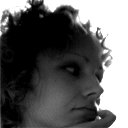
Нюша
бабушка, розы, старая волшебница, Кай и Герда, Снежная королева, тролль, волшебное зеркало, Ворон и Ворона, Принц и Принцесса, старуха-разбойница и маленькая разбойница, Финка, Лапландка, Северный олень
АМ
Александр Монахов
что то ты для сказок слишком взросло выглядишь.. .
Кай
Герда
их мать
Снежная королева
Принц и принцесса
Разбойница
сказочник
гном
ДШ
Дмитрий Шапилов
Кай — главный герой сказки;
Герда — главная героиня, не пожалевшая сил в времени, чтобы добраться до чертогов Снежной Королевы и спасти Кая;
Бабушка (бабушка Кая и Герды);
Тролль — создал ужасное кривое зеркало, осколок которого впоследствии попал Каю в сердце;
Снежная королева — женщина в белом, хозяйка Лапландии, королева снега и снежинок. Её прообразом была возлюбленная Андерсена оперная певица Йенни Линд, отвергшая любовь писателя.
Женщина, которая умела колдовать (волшебница) — имела цветник и помогла Герде на пути к Каю;
Ворон;
Ворона;
Принцесса;
Принц;
Разбойница — молодая девушка, промышлявшая грабежами с бандой разбойников, но сжалившаяся над Гердой;
Старуха (атаманша) — мать разбойницы;
Лапландка;
Финка;
Северный олень.
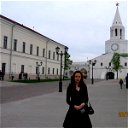
Елена
бабушка ворон и ворона оле лукойе лапландка олень финка разбойники король принц и принцесса тролль розы кай герда ст. волшебница в. зеркало

Гульнура
Бабушка, Розы, Старая волшебница, Кай и Герда, Снежная королева, Троль, Волшебное зеркало, Ворон и Ворона, Принц и Принцесса, Старуха-разбойница и Маленькая разбойница, Финка, Лапландка, Северный олень!
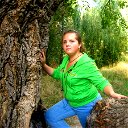
Оля
Добрые герои: Бабушка, Кай и Герда, Ворон и Ворона, Принц и Принцесса, Олень
Нейтральные герои: Старуха-разбойница и Маленькая разбойница
Злые герои: Снежная королева, Старая волшебница
СП
Сергей Пынзару
Это сказка Андерсена или пьеса Шварца? Если сказка Андерсена — в ней нет Сказочника и нет Оле Лукойе и еще многих (Ворона и Вороны, придворных стражников) , зато есть войско Снежной королевы, а если Шварц — там еще Король, и Министр, и Господин Тайный Советник, а Тролля и Оле Лукойе тоже нет. Кая у Шварца зовут Кей, принца — Клаус, а принцессу — Эльза.
Книги великого датского писателя и драматурга пользуются всемирной популярностью. Огромное место в его творчестве уделено произведениям для детей. Одним из них является сказка Андерсена «Снежная королева». Если верить рассказу одного из биографов, прототипом главной героини «Снежной королевы» стала безответная любовь Ганса Христиана певица Йенни Линд.
Главные герои
Снежная королева |
Снежная королева живет в Лапландии, в краю вечного холода и мерзлоты. Ее дворец сделан изо льда, и сама она холодная и бездушная женщина. От ее взгляда на окнах появляются узоры, она дышит морозом. Снежная королева является образом вечной зимы и смерти. Это очень умная и красивая женщина, но ее красота не несет добра, королева является воплощением зла и вечного безмолвия. Она не способна испытывать никаких чувств, всегда спокойна и равнодушна. |
Кай |
Названный брат Герды, добрый и отзывчивый мальчик, смелый и сильный. Он с уважением относится к старенькой бабушке, нежно любит Герду. Но однажды, к нему в глаз и в сердце, попали осколки волшебного зеркала, которое принадлежало злому троллю. С тех пор, сердце мальчика стало ледяным и холодным, а глаза стали видеть все уродливым и кривым. |
Герда |
В «Снежной королеве» герои могут не только подчиняться сверхъестественным силам, но и с честью выдерживать все испытания, не поддаваясь чарам и колдовству. Такой бесстрашной девочкой оказалась Герда. Отважно она пустилась на поиски пропавшего Кая. Она очень любит своего названого брата, чтобы найти и спасти его, Герда целеустремленно движется к цели, и побеждает злые чары Снежной королевы. |
«Снежная королева»: главные герои сказки
Сказка «Снежная Королева» увидела свет в 1844 году. Интересно, что у этой персонажей этого произведения были реальные прототипы. Так, прообразом Снежной королевы с ледяным сердцем стала оперная певица Йенни Линд, в которую сказочник был безумно влюблен. А Герда воплотилась из маленькой подружки детства Лисбет, с которой Ханс Христиан дружил в раннем детстве.
Главные герои сказки Андерсена «Снежная королева»:
Злой троль – воплощение всего злого. Он создал зеркало, которое добро уменьшало, а зло увеличивало до невероятных размеров.
Кай – мальчик, близкий друг Герды, жил напротив Герды тоже с родителями. Это был добрый мальчик, который любил своих родителей, розы, Герду, книжки с картинками до тех пор, пока ему в глаз не попал осколок дьявольского зеркала, созданного Троллем. После этого случая Кай сильно изменился. Он стал передразнивать знакомых и соседей, выставляя напоказ все их недостатки, передразнивал свою бабушку, в поступках людей, в предметах его окружавших, видел только плохое. Все ему не нравилось. Когда он катался с детьми на санках, его похитила Снежная королева.
Старушка, умевшая колдовать – добрая старушка, колдовала редко, ради собственного удовольствия. Она была очень одинокой и хотела оставить Герду у себя.
Принц и принцесса – молодые супруги, не лишенные справедливости, великодушия. Они щедро одарили Герду и пожелали счастливого пути.
Маленькая разбойница – своенравная девчонка, избалованная, упрямая. В ее сердце странным образом уживались жестокость с великодушием.
Старуха лапландка – жительница Лапландии, встретившаяся Герде и оленю на пути. Она была бедной, жила в ветхой лачуге.
Финка – маленькая толстая женщина. Любила тепло, в доме топила жарко. Была умной. К ней направила Герду лапландка.
Герда нашла Кая. Маленькой храброй девочке помогали люди, звери и птицы. Своими поцелуями Герда растопила лед в сердце Кая, он расплакался, и осколок, сидевший в его глазу, вытек вместе со слезами. Кай стал прежним. Они вернулись домой, и заметили, что за время своего отсутствия стали старше.
Сочинение про Герду
Написал однажды Г-Х. Андерсен волшебную сказку — «Снежная Королева». И это произведение запомнится каждому, кто его прочитает хотя бы один раз. В памяти останется не только сюжет повествования, но и прекрасные герои. Одним из главных персонажей является чудесная девочка – Герда.
Юная, но развитая не по годам, она имеет хорошее воспитание. Герда могла видеть прекрасное в самых простых и обыденных вещах. Даже банальные игры в снежки для нее становились чем-то захватывающим и особенным. Герда очень дорожит дружбой с соседским мальчиком Каем. Она очень преданный и верный товарищ.
Но кто мог подумать, что зима и разлучит этих юных ребят. Когда Кай попадает в беду и его сердце «замерзает» от чар злой Снежной Королевы, Герда не раздумывая, отправляется ему на помощь. Она, как настоящий друг, сразу заметила негативные изменения в характере и поведении Кая. Именно этим и привлекает Герда. Она самоотверженно направляется в сторону северного полюса: в край вечных льдин и холодов.
Настоящий образ Герды раскрывается во время ее захватывающего путешествия. Разве может обычная девочка преодолеть такое большое расстояние и ни разу не всплакнуть? Но Герда – необычный ребенок, ради дружбы ей не страшны никакие препятствия! Помимо внутреннего стержня, она обладала колоссально добрым и чутким сердцем. Вежливость Герды не имеет границ. Она уважительно относится даже к тем, кто не помог ей и держал некоторое время в темнице. Но никто не смог сломить ее дух: ни старая колдунья, ни разбойники. А некоторые, наоборот, еще больше поддерживали и подбадривали юную Герду. Например, старуха лапландка, которой северный олень рассказал историю путешествия Герды.
Девочка храбро преодолевала сильнейшую вьюгу, утопала в сугробах, имела дело со злыми людьми. Но многие попутчики старались ответить Герде «добром на добро». Ведь главная тема сказки – победа прекрасных чувств над злом. И образ Герды помогает раскрыть эту тему более чем полностью. Эта девочка полюбится читателям всех возрастов. Благодаря Герде, «черствый» и злой Кай стал прежним жизнелюбивым мальчишкой. Её нескончаемая вера в чудо смогла вновь разжечь в сердце Кая огонь. И это все несмотря на «леденящие» козни Снежной Королевы.
Герда не только спасла своего друга, но и получила большой опыт. Стала мудрее, чем была в начале зимы. Она запомнилась мне своей простотой и добротой. Девочка искренне верила в то, что Кай станет прежним. Именно любовь Герды «сотворила» чудо, и кусочек льда растаял в сердце ее друга. Такие сказки помогают людям стать более добрыми и искренними.
Характеристика
Ханс Кристиан Андерсен — христианский автор. Об этом говорит даже его имя. А что касается историй, так здесь и “Русалочка”, где главная героиня желала обрести бессмертную душу, и жуткие “Красные башмачки”, где Карен не могла переступить порог церкви, даже когда избавилась от дьявольских туфель, и многое-многое другое. Среди этих христианских сказок есть и “Снежная Королева”. Совсем не страшная, как те же “Красные башмачки”, и не особенно грустная, но переполненная христианскими символами. Бабушка Кая и Герды читает детям Евангелие, а ещё звучат слова псалма “Розы цветут… Красота, красота! Скоро узрим мы Младенца Христа”.
Кай и Герда живут душа в душу, но потом Каю в глаз и сердце попадают осколки зеркала, а вскоре появляется Снежная Королева и забирает его к себе. Герда же отправляется его искать и переживает множество приключений.
Каждое приключение Герды — это маленькое испытание. Вот она попадает к колдунье-цветочнице, милой на первый взгляд старушке, которая на самом деле держит девочку в плену, словно Калипсо — Одиссея. У колдуньи этой волшебный гребень, она расчёсывает девочке волосы, и та забывает о своём Кае, а в саду у неё нет ни одного розового куста. Когда же Герда понимает это, она вспоминает о том, что должна найти Кая, и снова отправляется в путь. Здесь проявляется верность и целеустремлённость Герды. Ведь её путешествие началось будто бы случайно. Она решила дать реке свою обувь, чтобы та взамен отдала ей якобы утонувшего Кая, но река унесла её на много миль от родного города к цветочнице. Здесь она уже целенаправленно идёт за своим названным братом в далёкий путь.
Андерсен замечает, что Герда босая. Она остаётся босой до самого конца истории. Может, это означает, что она думает только о родном человеке, и собственная обувь для неё — деталь, не стоящая внимания? Или Андерсен решил показать чистоту Герды, сделав отсылку к другому своему произведению? Ведь обувь, которой она лишилась, когда оказалась в лодке на реке, — это красные башмачки. Карен не может “узреть Господа”, но зато с башмачками, Герда всё время с Ним — но без башмачков. Интересная закономерность.
После этого Герда оказывается во дворце, где уговаривает Принца и Принцессу помочь ей. Здесь больше интересен не тот факт, что она растапливает сердца высоких особ, а то, что она разговаривает с Вороном и Вороной. До этого она говорила с цветами, теперь — с животными. То ли ещё будет…
После этого Герда оказывается в логове разбойников, и это уже испытание больше не для неё, а для дочери атаманши — Маленькой Разбойницы. Избалованная девчонка, которая никогда не расстаётся с острым ножом, меняется, услышав историю Герды, помогает бежать ей в Лапландию и даже отдаёт свою любимую “игрушку” — северного оленя.
Образ Герды предстаёт перед читателем всё ярче. Она располагает к себе людей, находит общий язык со всеми живыми существами и даже, как однажды выясняется, с явлениями природы.
Она отважно ступает во владения Снежной Королевы. Правильно говорила старуха-финка, никакой волшебный напиток не сделает её сильнее, чем она есть, и только собственная воля поможет ей победить в последнем испытании.
И Герда побеждает. Замок Снежной Королевы производит впечатление мёртвого, холодного, пустынного, хозяйка улетела по своим делам, а остался лишь Кай, складывающий из льдинок слово “Вечность”. Это сильный, врезающийся в память образ. Герда растапливает его ледяное сердце, он вспоминает её и плачет. Когда же осколок вместе со слезами вытекает из его глаза, он окончательно приходит в себя, и они беспрепятственно выходят из замка. Герде даже не удалось встретиться со Снежной Королевой. Но это и не было для неё главной задачей, она хотела лишь спасти Кая.
Итак, Герда — абсолютно положительный персонаж. Отважна, умеет находить общий язык со всеми существами и даже не замечает этого. Понимает, что насколько важны живые человеческие чувства. Жертвует уютом, теплом, удобством и даже собственной жизнью ради других. И при этом остаётся по-детски наивной. В этом и заключался замысел Андерсена: он создал христианский образ чистого, невинного ребёнка, способного выдержать десятки испытаний ради другого человека. И у него получилось.
Основная тема сказки
Сказка Ганса Христиана Андерсена о Снежной королеве — одна из известнейших и любимых во всем мире. Яркость и самобытность образов в ней оценена по достоинству. Вероятно, поэтому дети с удовольствием читают эту историю.
В основу характера Герды можно положить цитату мудрого оленя: «Сильнее, чем она есть, ее сделать нельзя». Эта мысль прошла через всю мировую литературу.
Среди помощников девочки не только люди, но и животные, а также птицы. Каждый поступок, который совершала Герда, заставлял окружающих помогать ей в поисках дворца Снежной королевы.
Чистота, милосердие и почти детская искренность героини, рассказать о которой Андерсен смог так живо, не оставляла равнодушными никого.
Целеустремленность и безграничная вера в то, что Кай будет освобожден, поражает читателей. Девочка уверена в правильности совершаемого пути, и это передается всем, кто встречается ей в дороге. Сомнений, что столь хрупкое дитя сможет преодолеть все невзгоды и преобразить окружающий мир ради близкого ей человека, нет ни у кого. Она служит примером стойкости, сердечности и любви к человеку. Все это помогло хрупкой девочке противостоять силам зла.
Сказка имеет счастливый конец. Но далеко не все истории великого датского сказочника могут этим похвастаться. Возможно, горючие слезы, растопившие ледяное сердце Кая, тронули и душу писателя.
Краткое содержание
Даже краткое содержание «Снежной королевы» для читательского дневника придется разбить на главы, поскольку каждая из них самобытна, наполнена событиями и по-своему интересна. Но если пересказать сюжет «Снежной королевы» кратко, как если бы была нужна только аннотация к книге, то его можно свести к следующему.
Жила на свете Герда. Дружила с мальчиком по имени Кай. Они были неразлучны с самого детства. Но однажды мальчику попал в глаз осколок волшебного зеркала, из-за которого Кай все теперь видит в самом неприглядном свете. Он становится злым, но Герда все равно его любит. Когда Кая забирает в свои ледяные чертоги королева, маленькая Герда отважно отправляется в опасное путешествие, чтобы спасти своего друга.
Более полное описание произведения состоит в следующем:
- Рассказ первый. Он называется «Зеркало и осколки». Это предыстория всей сказки, она повествует о том, что однажды самый злобный тролль изготовил зеркало, которое даже все доброе и светлое делало злым. Ученики мастера потехи ради повсюду бегали с этим зеркалом, и однажды они решили подняться на небеса, чтобы посмеяться над ангелами и Богом. Но чем выше поднимались они, тем тяжелее было удерживать в руках гримасничающее зеркало. Оно вырвалось у троллей из рук, упало на землю и разбилось. Некоторые осколки пошли на то, чтобы смастерить очки, другие были вставлены в оконные рамы, но хуже всего было то, что некоторым людям осколки попали прямо в сердце, превратив его в кусочек льда.
- Рассказ второй знакомит с Каем и Гердой. Он так и называется — «Мальчик и девочка». Они дружат с детства и много времени проводят вместе. Однажды, когда они сидели в своем садике, который вырастили под крышей, Каю в глаз попал осколок волшебного зеркала, о котором рассказывала предыдущая глава. С тех пор мальчик начинается смеяться над Гердой и над окружающими, его больше не радует красота роз, ему нравятся только снежинки. А однажды его увозит с собой королева.
- Рассказ третий повествует о том, как Герда отправилась на поиски Кая. Вскоре она встретила женщину, умеющую колдовать, которой очень понравилась девочка, и она захотела оставить ее у себя. С помощью магии она сделала так, чтобы Герда забыла обо всем. Чтобы ничего не напоминало ей о Кае, женщина даже прячет все розы у себя в саду. Но забывает спрятать те, что украшали ее шляпу. Герда видит эти розы, все вспоминает и после этого слушает необыкновенные истории, которые рассказывают ей волшебные цветы, и снова пускается в путь.
- Рассказ четвертый знакомит читателя с придворными воронами и очаровательной принцессой. Из разговора воронов Герда узнает, что жених принцессы родом из чужих краев, она думает, что это Кай, но ошибается. К счастью, принцесса оказывается доброй девушкой, узнав историю Герды, она дарит ей и новое платье, и башмаки, и хорошенькую муфту, и роскошную карету, чтобы она быстрее нашла своего друга, да еще отправляет с ней целую свиту.
- Рассказ четвертый называется «Маленькая разбойница». Роскошная карета привлекает внимание местных разбойников. Они нападают на Герду, расправляются с ее кучером и слугами, забирают все ее вещи себе. Но Герде повезло. Она понравилась маленькой разбойнице, дочке атаманши этой банды, и та спасает героиню. Разбойница кажется жадной и упрямой, но в глубине души она неплохая. В итоге разбойница отпускает Герду и дает ей своего Северного оленя, который знает, где находится дворец Снежной королевы. И выясняется, что Герде нужно добраться до самого Северного полюса.
- Рассказ шестой. В пути Герда и ее олень встречают гостеприимную лапландку. Она узнает их историю и советует путникам отправиться к ведунье-финке. Та дает оленю питье, которое придает сил, но Герде такое снадобье не нужно, ведь ее сила — в ее добром сердце.
- Рассказ седьмой. В этой части северный олень оставляет девочку одну, дальше идти он не может. Герда, несмотря на все препятствия, на страшную бурю, через которую ей приходится идти, даже не имея теплых сапог и рукавиц, попадает во дворец Снежной королевы, где она встречает Кая, поет ему их любимый псалом про розы, и он все вспоминает. Когда дети возвращаются домой, то по дороге встречают молодую разбойницу, которая выросла и захотела посмотреть мир. А придя в свой маленький розовый сад, обнаруживают, что стали взрослыми.
«Снежная королева» главные герои сказки Андерсена известны практически всем.
«Снежная королева» Андерсен главные герои
Герда — главная героиня сказки. Этой девочке удалось найти своего друга Кая и спасти его от Снежной королевы.
Кай — маленький мальчик, который живет в большом городе, на чердаке здания через дорогу от дома Герды. Он становится жертвой осколков зеркала-тролля. Кая увозит Снежная королева.
Снежная королева — королева снежинок, которая путешествует по всему миру со снегом. Ее дворцы и сады находятся в землях вечной мерзлоты. Она привозит Кая в свой дворец после того, как он стал жертвой осколков зеркала-тролля. Она обещает освободить Кая, если он может сложить «вечность» кусками льда.
Тролль — создает злое зеркало, искажающее реальность.
Бабушка Кая — рассказывает внуку и Герде легенду о Снежной королеве. Некоторые действия бабушки — важные моменты истории.
Старая волшебница — живет возле реки. В ее саду всегда лето. Она пытается удержать Герду, но увидев розу Герда (любимый ее цветок и Кайя) вспоминает Кая и пробуждается от волшебства старухи.
Ворон — который считает, что новым принцем его земли является Кай.
Принцесса — хочет, чтобы принц-супруг был таким же умным, как и она. Принцесса находит Герду в своем дворце. Она помогает Герде в поиске Кая, дает ей теплую, красивую одежду, слуг и золотую карету.
Принц-бывший бедный молодой человек. Вскоре должен стать принцем.
Старая атаманша — единственная женщина среди разбойников, которые захватывают Герду, когда она едет в поисках Кая в золотой карете.
Маленькая девочка-разбойница— дочь атаманши. Она подружилась с Гердой. Ее пленные голубки и северный олень рассказывают Герде, что Кай со Снежной королевой. Затем девушка-грабитель помогает Герде продолжить путешествие, чтобы найти Кая. Жизнь Маленькой разбойницы была невесёлой, без ласки и доброты. Разбойница была избалована, своевольна. Она держала в клетках животных и птиц, мучила их. Мать её или грабила, или пила из своей бутылки и после этого храпела. Но все-таки у Маленькой разбойницы было доброе сердце, ей тоже хотелось любви и душевного тепла, и она отпустила Герду и оленя в Лапландию.
Северный олень — доставляет Герду в дворец Снежной королевы.
Лапландка — предоставляет убежище Герде и оленю, и пишет сообщение о высушенной рыбе треске финке.
Финка — живет всего в двух милях от садов и дворцов Снежной королевы. Она знает секрет силы Герды, и говорит, что у нее получится спасти Кая.
Волшебные помощники Герды
Герде помогают цветы, ворон и ворона, Маленькая разбойница, лесные голуби и северный олень. Финка так сказала северному оленю: «- Сильнее, чем она есть, я не могу её сделать. Не видишь разве, как велика её сила? Не видишь, что ей служат и люди и животные? Ведь она босая обошла полсвета! Но она не должна от нас узнать о своей силе, что живёт в её сердце; её сила в том, что она невинный милый ребёнок».

